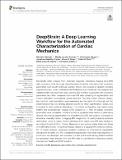| dc.contributor.author | Morales, Manuel A | |
| dc.contributor.author | van den Boomen, Maaike | |
| dc.contributor.author | Nguyen, Christopher | |
| dc.contributor.author | Kalpathy-Cramer, Jayashree | |
| dc.contributor.author | Rosen, Bruce R | |
| dc.contributor.author | Stultz, Collin M | |
| dc.contributor.author | Izquierdo-Garcia, David | |
| dc.contributor.author | Catana, Ciprian | |
| dc.date.accessioned | 2022-07-20T17:04:00Z | |
| dc.date.available | 2022-07-20T17:04:00Z | |
| dc.date.issued | 2021 | |
| dc.identifier.uri | https://hdl.handle.net/1721.1/143900 | |
| dc.description.abstract | <jats:p>Myocardial strain analysis from cinematic magnetic resonance imaging (cine-MRI) data provides a more thorough characterization of cardiac mechanics than volumetric parameters such as left-ventricular ejection fraction, but sources of variation including segmentation and motion estimation have limited its wider clinical use. We designed and validated a fast, fully-automatic deep learning (DL) workflow to generate both volumetric parameters and strain measures from cine-MRI data consisting of segmentation and motion estimation convolutional neural networks. The final motion network design, loss function, and associated hyperparameters are the result of a thorough <jats:italic>ad hoc</jats:italic> implementation that we carefully planned specific for strain quantification, tested, and compared to other potential alternatives. The optimal configuration was trained using healthy and cardiovascular disease (CVD) subjects (<jats:italic>n</jats:italic> = 150). DL-based volumetric parameters were correlated (&gt;0.98) and without significant bias relative to parameters derived from manual segmentations in 50 healthy and CVD test subjects. Compared to landmarks manually-tracked on tagging-MRI images from 15 healthy subjects, landmark deformation using DL-based motion estimates from paired cine-MRI data resulted in an end-point-error of 2.9 ± 1.5 mm. Measures of end-systolic global strain from these cine-MRI data showed no significant biases relative to a tagging-MRI reference method. On 10 healthy subjects, intraclass correlation coefficient for intra-scanner repeatability was good to excellent (&gt;0.75) for all global measures and most polar map segments. In conclusion, we developed and evaluated the first end-to-end learning-based workflow for automated strain analysis from cine-MRI data to quantitatively characterize cardiac mechanics of healthy and CVD subjects.</jats:p> | en_US |
| dc.language.iso | en | |
| dc.publisher | Frontiers Media SA | en_US |
| dc.relation.isversionof | 10.3389/FCVM.2021.730316 | en_US |
| dc.rights | Creative Commons Attribution 4.0 International license | en_US |
| dc.rights.uri | https://creativecommons.org/licenses/by/4.0/ | en_US |
| dc.source | Frontiers | en_US |
| dc.title | DeepStrain: A Deep Learning Workflow for the Automated Characterization of Cardiac Mechanics | en_US |
| dc.type | Article | en_US |
| dc.identifier.citation | Morales, Manuel A, van den Boomen, Maaike, Nguyen, Christopher, Kalpathy-Cramer, Jayashree, Rosen, Bruce R et al. 2021. "DeepStrain: A Deep Learning Workflow for the Automated Characterization of Cardiac Mechanics." Frontiers in Cardiovascular Medicine, 8. | |
| dc.contributor.department | Harvard University--MIT Division of Health Sciences and Technology | |
| dc.contributor.department | Massachusetts Institute of Technology. Department of Electrical Engineering and Computer Science | |
| dc.relation.journal | Frontiers in Cardiovascular Medicine | en_US |
| dc.eprint.version | Final published version | en_US |
| dc.type.uri | http://purl.org/eprint/type/JournalArticle | en_US |
| eprint.status | http://purl.org/eprint/status/PeerReviewed | en_US |
| dc.date.updated | 2022-07-20T17:00:10Z | |
| dspace.orderedauthors | Morales, MA; van den Boomen, M; Nguyen, C; Kalpathy-Cramer, J; Rosen, BR; Stultz, CM; Izquierdo-Garcia, D; Catana, C | en_US |
| dspace.date.submission | 2022-07-20T17:00:12Z | |
| mit.journal.volume | 8 | en_US |
| mit.license | PUBLISHER_CC | |
| mit.metadata.status | Authority Work and Publication Information Needed | en_US |
